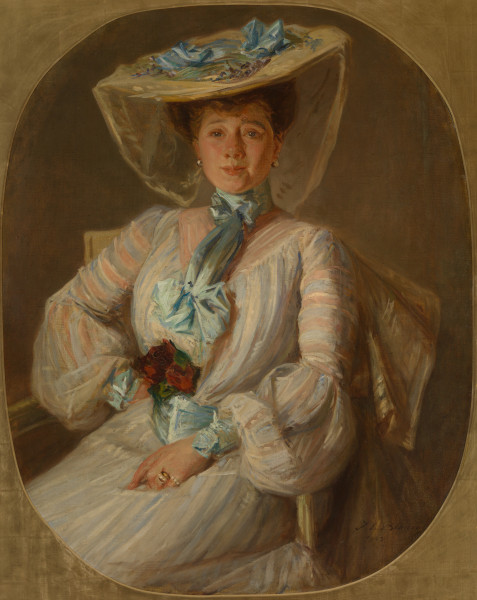Home
/
G0794
Paintings: G0794
Title
Dame Marie Tempest
Technique
Oil on canvas
Subject
Artist
Date
1903
Dimensions
Height: 101.5cm
Width: 81.5cm
height (frame): 121cm
width (frame): 101cm
Width: 81.5cm
height (frame): 121cm
width (frame): 101cm
Inscription/signature
"J. E. Blanche / 1903" (brown paint b. r.)
Provenance
Presented by Alderson Burrell Horne, Sir Alfred Webb-Johnson, and Lt Col Philip Walker, 1943
Other number
CKA 640
Gift 613
Gift 613
Exhibition history
1949 Birmingham, City Museum and Art Gallery, "Painters and the Theatre" (5)
1949 Port Sunlight, Lady Lever Art Gallery, "Theatre Exhibition" (9)
1951 London, Tate Gallery, "Pictures from the Garrick Club" (2)
1974 Folkestone, Arts Centre, New Metropole, The Leas, "Edwardian Exhibition"
1975 Bradford, Cartwright Hall, "Edwardian Reflections"
1997-1998 Rouen, Museé des Beaux-Arts "Jacques Emile Blanche, Peintre (1861-1942)"
Literature
J. E. Blanche “Portraits of a Lifetime” (1937), p. 96
Marie Tempest sits, wearing a long-sleeved dress of blue and white vertical stripes, with a broad blue belt and blue bows at the wrists, and a broad blue ribbon round the neck tied in a bow at the front with ends hanging down. She wears a broad-brimmed straw hat with blue ribbons on top.
Marie Tempest met her second husband, Cosmo Gordon-Lennox, in 1898. They married soon afterwards, and spent much of their time in France, where they became important social figures in the British colony at Dieppe. Neighbours included Max Beerbohm, Percy Grainger, and Walter Sickert, as well as the anglophile Jacques-Emile Blanche. Blanche was a particular friend of Gordon-Lennox, who, with Harry Melville, wrote a skit entitled “A Painting Class as Boarding House”, based on incidents taking place in Blanche's studio in Dieppe. Blanche frequently commuted to London, so that his portrait of Marie Tempest could have been painted there or in Dieppe, or even in Paris where Gordon-Lennox and his wife spent several days every month.
Marie Tempest met her second husband, Cosmo Gordon-Lennox, in 1898. They married soon afterwards, and spent much of their time in France, where they became important social figures in the British colony at Dieppe. Neighbours included Max Beerbohm, Percy Grainger, and Walter Sickert, as well as the anglophile Jacques-Emile Blanche. Blanche was a particular friend of Gordon-Lennox, who, with Harry Melville, wrote a skit entitled “A Painting Class as Boarding House”, based on incidents taking place in Blanche's studio in Dieppe. Blanche frequently commuted to London, so that his portrait of Marie Tempest could have been painted there or in Dieppe, or even in Paris where Gordon-Lennox and his wife spent several days every month.

